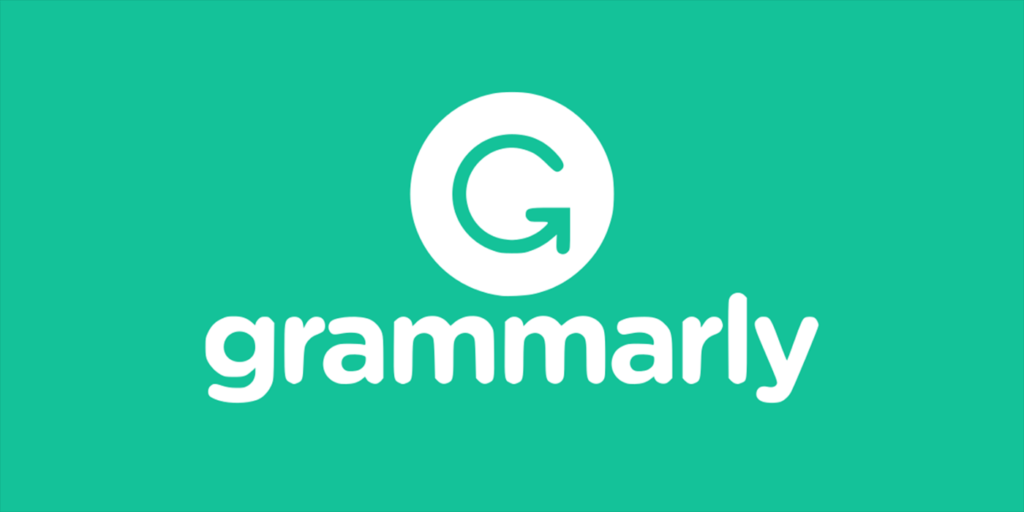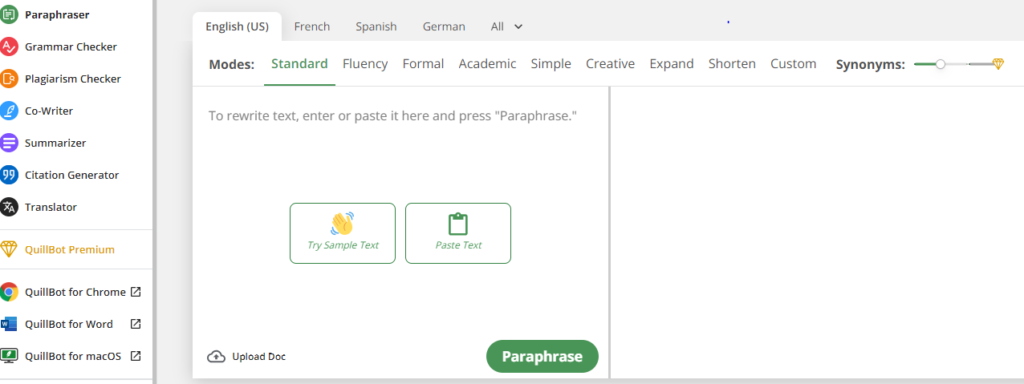Grammarly and Quillbot have been my writing assistants since forever.
While Grammarly helps me write error-free and original content, QuillBot comes in handy for projects where much paraphrasing is needed.
However, just because I use both these writing tools together doesn’t imply that everyone else does.
Also, now that QuillBot checks for grammatical errors (it didn’t for a long time), you can use it for much more than rephrasing.
Similarly, with the arrival of GrammarlyGO, Grammarly has gone beyond its original purpose – besides checking spelling, punctuation, and grammatical errors, it can do pretty much everything ChatGPT does.
Our Grammarly vs. QuillBot comparison has more.
Our rating:
- Grammarly: 4.5/5
- QuillBot: 4.2/5
| Criteria | Grammarly | QuillBot |
| Ease of Use | User-friendly interface | Superb |
| Customization | Offers a large number of customization options | Paraphraser offers multiple customization modes |
| Analysis Reports | Provides basic analysis reports for grammar, punctuation, spelling, engagement, clarity, and more. | Ditto |
| Rephrasing Tools | Allows you to rephrase your writing pretty much any way you want (especially if you opt for GrammarlyGO) | Fairly advanced |
| Integrations | Integrates with almost every app a writer could use | Integrates with most apps, platforms, and software |
| Pricing and Support | Prices aren’t cheap but won’t blow a hole in your pocket either | Pocket-friendly |
| Accuracy | Highly accurate in identifying and correcting grammar, punctuation, and spelling errors. | Plagiarism detector can be more accurate |
| Writing Style | Lets you pick from predefined writing styles | N/A |
| Plagiarism Checker | There are better (and more reliable) options out there | Same |
| Mobile Integration | Yes | Yes |
| Educational Material | I am yet to come across any | The site has some excellent explainers |
| User Reviews | Routinely gets 4.5* out of 5 | Overwhelmingly positive |
| Free vs Paid Plans | Free plan: No restrictions and includes tone detection Paid Plan: Includes a plagiarism checker | Plagiarism detection, summarize, citation generator features are only available in the paid version |
| Writing Goals | Lets you set your writing goals in advance as well as change them down the line | Same |
| Language Support | Only English | Works with multiple languages |
Table of Contents
Overview: What both tools are about?

Grammarly is an AI-powered writing tool whose original goal at the time of its release was to point out and correct grammatical and spelling mistakes in your writing.
However, like everything in life, it has branched over the years.
While it still does the above, the Grammarly of 2023 helps you write new content from scratch, offers new ideas to expand your creative horizons, and suggests prompts you can select to improve your writing.
Additionally, Grammarly lets you tailor your writing by:
- Target audience (general, knowledgeable, expert),
- Formality (formal, informal, neutral),
- Domain (general, business, academic, technical, casual, and creative)
A built-in plagiarism detection tool is one of Grammarly’s most popular features. However, as I will prove in the coming paragraphs, it might not be as accurate as it’s made to be.

Quillbot, like Grammarly, is an AI-based writing assistant that rephrases your content, checks for grammar and spelling errors, and detects duplication (if any) in your content.
Other notable features include summarizing large documents in key points, generating citations for any book, PDF, or webpage, and translating content from 21 different languages into English (and vice versa).
Finally, we have the Co-Writer – an all-in-one writing space that combines all the above features in one location, letting you write, paraphrase, create citations, and summarize any document inside a single workspace.
Seems like there aren’t many differences between Grammarly and QuillBot? Wait till you have read the upcoming sections.
Ease of Use: How user-friendly are the interfaces of each product?
Both Grammarly and QuillBot have user-friendly interfaces.
Take the example of Grammarly, whose web editor and MS Word plug-in compete with each other to be more accessible to the end-user.
Need proof? Here’s a screenshot of Grammarly’s menu on MS Word. Notice how neatly all the menus are laid out, leaving zero room for confusion.

The same thing can be said about Grammarly’s web editor.
Here, the top-down menu is replaced by the sidebar. Yet one thing has remained unchanged – the ease with which you can navigate the options on offer.

QuillBot’s interface is equally user-friendly.
Upon visiting its website, you’d be welcomed by the following screen:

Notice how all of QuillBot’s features are neatly listed on the left-hand side?
This makes it nearly impossible that you won’t find what you came looking for (as long as QuillBot is offering it).
Once you have selected the feature you want to work with, the workspace in the center will reflect your choice, letting you work right here on the website rather than switching back and forth between whatever tool you use for writing and QuillBot.

Thus, as far as the user-friendliness of their interfaces is concerned, Grammarly and QuillBot are equally approachable to beginners.
Customization: How customizable are the settings and options for each product?
One of the things that has helped me stay loyal to Grammarly over all these years is that it offers a wealth of customization options.
Grammarly lets its users create a personal dictionary, pick from three different citation styles, use/avoid passive voice, and much more.

The best news is yet to come.
Grammarly also lets you customize the suggestions it offers based on your goals and target audience.

QuillBot only lets you customize the paraphrasing suggestions it offers.
It offers different modes (standard, fluent, formal, academic, simple, creative, expand, concise, and custom), with each mode focusing on specific things in your text.
For instance, while the formal mode changes your text to read and sound more professional, creative mood might end up changing the meaning of the text altogether.

Thus, as far as options for customization are concerned, Grammarly is a clear winner.
Analysis Reports: What types of reports does each product offer to help users improve their writing?
Here’s one area where it’s hard to pick a clear winner.
On every piece of writing that it’s checking (or has already checked), Grammarly gives you a PDF report on general metrics and writing issues needing resolution.

Additionally, you get a weekly email highlighting:
- How productive you were over the last week,
- Number of errors Grammarly found in your writing,
- Your accuracy compared to fellow Grammarly users.

QuillBot offers similar reports as well.
Upon pasting your content into QuillBot’s grammar-checking workspace, click on the ‘⋮’ icon at the bottom right corner of your screen, and you’ll see stats like these below:

What do I think about such reports?
Frankly, they aren’t of much use to me. I’d be much more interested if the reports were more in-depth, like the ones ProWritingAid offers.
ProWritingAid offers reports on repetition, vague wording, sentence length variation, over-used adverbs, and difficult-to-read sentences.
Now, those are the kind of reports that could actually help a writer improve their craft, not the bland ones Grammarly and ProWritingAid offer.
Rephrasing Tools: How effective are the rephrasing tools for each product?
QuillBot’s rephrasing tool (which it calls paraphraser) is highly advanced yet easy to use, even for users who have never used it before.
That is because it lets you change many things when paraphrasing, including:
- Modes: Modes are a setting that changes what the QuillBot paraphrase will focus on your text. There are seven modes: standard, fluency, formal, simple, creative, concise, and expand.
- Synonyms Slider: This option affects how many words are replaced with synonyms. It comes in the form of a slider, which you can adjust to have more or fewer words replaced.
- General Settings: If you click on the gear icon on the top right corner of your screen, you can adjust various settings. These include English dialect, contraction usage, and paraphrasing of quotations.
Grammarly also lets you decide which type of paraphrasing suggestions you want to see, albeit indirectly.
The type of paraphrasing suggestions Grammarly offers depends on the ‘Goals’ you have selected from the menu bar.

So, which product’s rephrasing tool is more effective?
My vote goes to QuillBot, whose paraphraser (I have never liked this name) is far more user-friendly and advanced than Grammarly’s.
Integrations: How well does each product integrate with other platforms and tools?
Grammarly integrates with (almost) every platform and writing tool available.

To further sweeten the deal, it provides API access to anyone interested.
This allows developers to easily incorporate Grammarly’s real-time writing aid into their software or apps.

QuillBot also integrates with all the software that Grammarly and Quillbot support, such as Microsoft Word, Google Docs, Google Chrome, Microsoft Edge, and more.
You can also integrate it with more sophisticated word processors like Scrivener and First Draft. A QuillBot API is on offer as well, letting you bring real-time QuillBot support to your app by adding a few lines of code.
Pricing and Support: How do the pricing plans and customer support options compare between the two products?
Here’s what Grammarly charges for its services:

Here are the prices for QuillBot monthly, annual and six-monthly plans:

If price is your primary concern, QuillBot is the clear winner.
Accuracy: How accurate are the suggestions and corrections offered by each product?
Grammarly is pretty accurate at highlighting and correcting grammatical errors and spelling mistakes, cutting down the overuse of passive voice and adverbs, and letting you write in a style your audience would understand.
Similar good things can be said about QuillBot.
Although its main focus is on rephrasing your content (which it does far better than Grammarly), QuillBot also does a more-than-passable job of correcting grammatical mistakes, highlighting duplicated content, and more.
That both these writing assistants are as accurate as I claim shouldn’t be surprising. After all, no software can thrive in the crowded market of writing apps unless it’s very good at what it’s supposed to do.
Writing Style: How well does each product cater to different writing styles and genres?
Grammarly lets you pick from six different writing styles, including:
- Academic
- Business
- General
- Technical
- Casual
- Creative
QuillBot also offers multiple modes in its rephrasing tool, including:
- Standard
- Formal
- Academic
- Creative
- Custom
While Grammarly allows you to write, edit, and rephrase text in various writing styles and genres, QuillBot mainly provides these options within its rephrasing tool.
This means that when it comes to functionality, QuillBot has fewer features to offer in comparison.
Educational Material: What type of educational material and resources do each product offer to help users improve their writing skills?
Grammarly doesn’t offer much in terms of educational material.
As a result, if you need help to make the best use of this app, independent tutorials on YouTube are your best friend.
Luckily, that isn’t the case with QuillBot.
QuillBot’s website has excellent explainers on almost every feature that you can find on the app, thereby helping you make the most of the subscription.
Free Vs Paid Plans: How do the free and paid plans for each product compare in terms of features and value?
Various differences exist between Grammarly’s and QuillBot’s free and paid plans.
Here’s a comparison of Grammarly’s paid and free versions:
| Features | Grammarly Free Version | Grammarly Paid Version |
| Basic Editing Checks | Yes | Yes |
| Suggestions To Improve Correctness | Yes | Yes |
| Suggestions To Improve Clarity | Yes | Yes |
| Suggestions To Improve Reader Engagement | No | Yes |
| Style Guide | No | Yes |
| Plagiarism Checker | No | Yes |
| Passive Voice Misuse Checker | No | Yes |
| Improper Formatting Checker | No | Yes |
| Alternate Word Suggestions | No | Yes |
| Get Help From Expert Writers | No | Yes |
QuillBot Free and Premium plans are equally different.
While the free plan gives you access to standard and fluency paraphrasing modes, the premium plan offers five additional settings (formal, simple, creative, expand, and shorten) to choose from.
Here’s a comparison of QuillBot’s Free and Paid versions:
| Features | QuillBot Free Version | QuillBot Paid Version |
| Words in Paraphraser | 125 | Unlimited |
| Fluency Modes | Standard and Fluency | Unlimited Custom + 8 pre-defined modes |
| Use of Synonym Slider | Limited | Full Use |
| Freeze Words | 1 | Unlimited |
| Summarizer | Limited to 1,200 words | Limited to 6,000 words |
| Plagiarism Checker | No | Yes |
| Paraphrasing History | No | Yes |
| Tone Insights | No | Yes |
| Recommended Rewrites | No | Yes |
| Compare Modes | No | Yes |
Language Support: How many languages do each product support for grammar and spelling checks?
Grammarly only provides English language support.
However, it lets users customize their writing to a specific English audience, including American, Canadian, Australian, and British.

Different versions of QuillBot work with multiple languages.
Paraphraser and Translator support multiple languages, including Afrikaans, Chinese, Danish, Dutch, French, German, Hindi, English, and multiple others.
Grammar checker works with English, French, German, and Spanish, though Co-Writer, Summarizer, Citation Generator, and Plagiarism Checker are available in English only.
Alternatives: What alternatives are there to both of these tools?
Here are the various alternatives to these apps:
- Microsoft Editor
- Hemingway
- ProWritingAid
- WordTune
- ChatGPT
- Autocrit
- Scrivener
- Ginger
Plagiarism Checker: How effective are the plagiarism-checking tools for each product?
As noted above, Grammarly offers a plagiarism checker in its paid plan.
However, I have found that Grammarly isn’t as effective at detecting duplication in your content as dedicated plagiarism checkers like Copyscape.
Thus, if originality is the primary goal, don’t rely on Grammarly’s plagiarism checker.
Quillbot also offers plagiarism checking in its paid version.
Unlike Grammarly’s plagiarism checker, which lets you scan as much content as you want, QuillBot’s plagiarism detector can scan only 20 pages a month (including around 5000 words each).
Unfortunately, that is where the differences end. In my experience, QuillBot’s plagiarism detector isn’t wholly reliable, especially when compared to tools like Copyscape, which focus entirely on plagiarism detection.
Frequently Asked Questions
Is Grammarly better than QuillBot?
Grammarly is better than Quillbot when it comes to detecting grammar and spelling errors. It also fares better at generating new content from scratch.
Is it worth paying for Grammarly?
It’s worth paying for Grammarly if you want to write high-quality, error-free, and audience-focused content.
Grammarly vs. QuillBot: Which One Comes Out On Top?
Both these writing apps have the potential to take your writing to the next level, especially if you know what their strengths and weaknesses are.
Pick Grammarly if you:
- Prioritize detecting and correcting grammatical errors and spelling mistakes in your writing.
- Are looking for a tool that can help generate new content from scratch and provide creative suggestions.
- Intend to tailor your writing to specific audiences, styles (e.g., formal, casual) and domains (e.g., business, academic).
- Work primarily in English, with a focus on American, Canadian, Australian, or British English.
- Appreciate an extensive range of customization options, including creating a personal dictionary, getting goal-based suggestions, and choosing citation styles.
Select QuillBot for:
- Advanced paraphrasing capabilities
- Translation services for multiple languages
- Summarizing large documents into key points
- Generating citations for various sources, including books, PDFs, or webpages
- Specific paraphrasing modes (e.g., formal, creative) and synonyms adjustment.

Meet Amir Bashir, our skilled content writer at Keep Writing with over 12 years of freelancing experience. Specialising in article and blog writing, Amir prioritises readability, crafting engaging content while avoiding lengthy sentences and passive voice. He’s committed to delivering valuable and actionable insights to readers, ensuring each piece is unique and relevant. At Keep Writing, we uphold the highest writing standards, offering inspiration, knowledge, and actionable tips to help you elevate your writing skills.
Discover reviews about Amir here: https://www.upwork.com/freelancers/~0161fac3318973b96c

